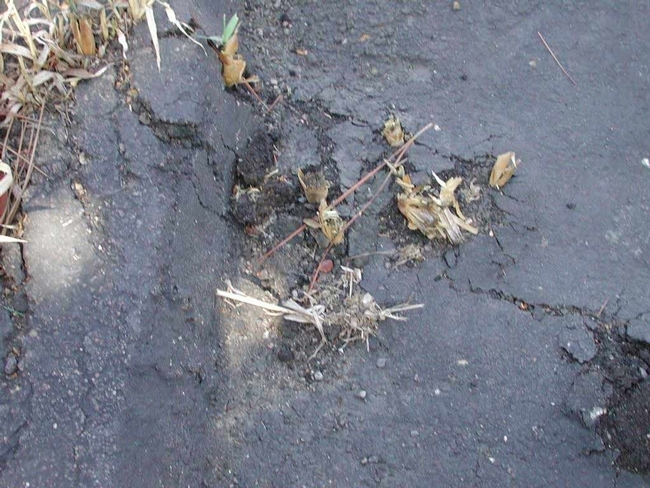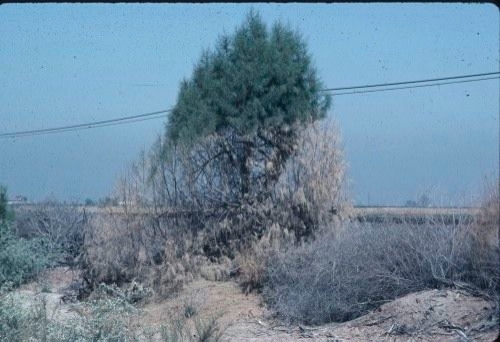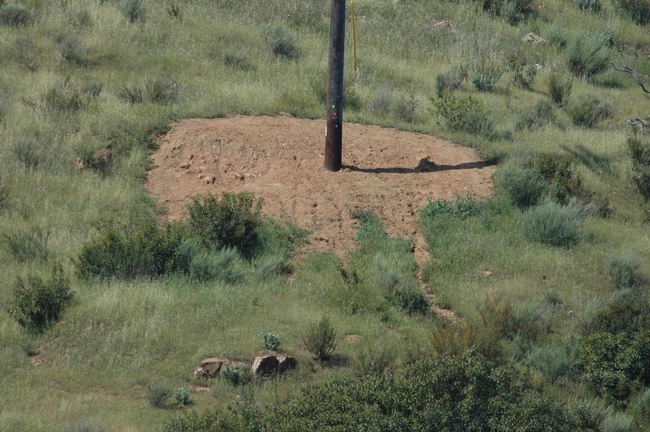A recent blog post titled–Plant growth and development and herbicide efficacy discussed herbicides like glyphosate and imazapyr that move through plants in the sugar conducting tissues (aka phloem or symplastic system).





Others, such as diuron or bromacil are used to some in roadsides, under pavement, industrial areas, railroad beds, and under utility lines and poles. The valuable characteristics of diuron, bromacil, etc is that they are very broad-spectrum (e.g. they kill a large number of plant species), they persist in the soil for months to years, and they are low cost relative to newer herbicides. Their use is often pretty obvious, however, especially if they are not applied correctly.
These few photos demonstrate their utility and also their problems. For example, the first photo (1) shows giant reed shoots coming up under the blacktop in a parking lot near a small drainage/creek in San Diego. Clearly, if you owned the parking lot you wouldn't be happy. It is a fairly common practice to apply one of these herbicides, at high rates, to the soil before the pavement is laid down. That doesn't look like it was done in this case. On the other hand, this parking lot is about 20 feet from the drainage channel and all such channels in San Diego go to the ocean, so it doesn't seem like using a heavy-duty herbicide in this situation would have been a good idea.
The next photo (2) shows a saltcedar shrub next to a railroad track. The railroad companies spray these types of herbicides on the roadbed to keep weeds down. Makes sense, you couldn't run a train very well or safely if there were lots of weeds covering the tracks. But in this case, the spray was a little high, don't you think?
By the way, diuron, bromacil and related herbicides move upward in plants in the xylem, but when they are sprayed to foliage, they don't move very much at all. This visibly damaged saltcedar recovered and continued growing, just with very few leaves on the lower part of the plant. The following two photos (3 and 4) show the different symptoms of applying the herbicide prometryne to the soil and moving up to the leaves, a cotton plant on the left with typical inter-veinal chlorosis (yellowing) from soil uptake, versus a foliar application of the same herbicide to romaine lettuce showing a desiccate leaf, but no effect on the younger leaves.
This last photo (5) was taken in a nature reserve, which happens to have power lines running through it. The power or telephone companies are required to keep an area around the poles free of vegetation to protect the pole from fires. Seems reasonable, but the downhill trail of excess herbicide is not so good and attracts attention to the use of strong herbicides around the pole.
The persistence of these herbicides, their propensity to move with water off of a site, their obvious symptomology, and the increase of weed species that have evolved resistance to them has led to a great reduction in their widespread use. Newer, more environmentally friendly herbicides have been replacing them in recent decades, but if you know what to look for you will see them.